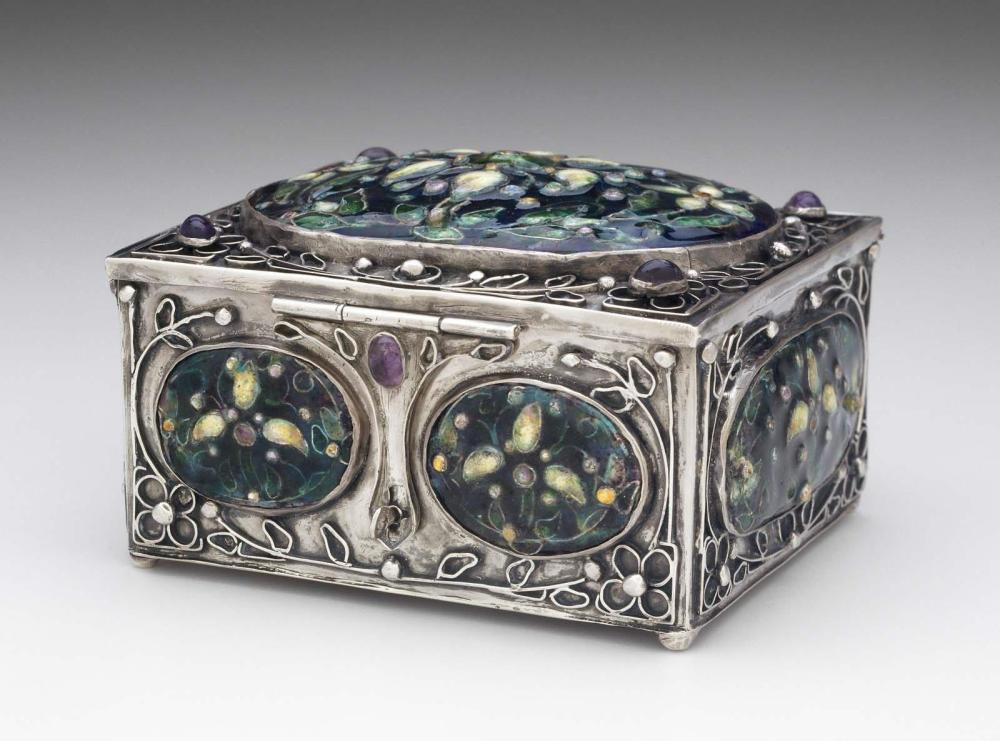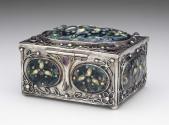Advanced Search
Box
Elizabeth Ethel Copeland (American, 1866–1957)
1912
Object Place: Boston, Massachusetts, United States
Medium/Technique
Silver, enamel, amethyst
Dimensions
8 x 12.8 x 11.5 cm (3 1/8 x 5 1/16 x 4 1/2 in.)
Credit Line
Gift of Mrs. Horatio Appleton Lamb in memory of Mr. and Mrs. Winthrop Sargent
Accession Number19.5
CollectionsAmericas
ClassificationsSilver hollowware
Elizabeth Copeland was one of New England’s most prominent enamelists of the Arts and Crafts period. She was born in Revere, Massachusetts, and from 1896 to 1900 attended the Cowles Art School in Boston, where she studied design with Amy Sacker (1876 – 1965).** She probably learned metalsmithing from Laurin Hovey Martin, who became the first professor in this medium at the Massachusetts College of Art in 1901. Martin had recently returned from England, where he had studied at the Birmingham School of Art and with master enamelist Alexander Fisher (1864 – 1936) in London. In 1905 Copeland attended a summer course titled “Principles of Design,” offered at Harvard College by Denman Ross, a Museum of Fine Arts trustee; there she met artists and teachers from around the country.
Copeland was thirty-four years old when she began her studies at Cowles and wasted little time in establishing her career. Evidence of her talent was noted as early as 1903, when her enamelwork appeared in The Craftsman. Soon after, she was featured in an essay by Syracuse University professor Irene Sargent. The article recounted Copeland’s student years spent commuting three times per week between Revere and Boston. The artist recalled performing her domestic duties at home while studying assigned design problems, which she pinned above her ironing board, noting dryly: “No doubt the garments suffered.”
At Cowles, Copeland was befriended by Sarah Choate Sears (1858 – 1935), a Boston collector, Museum of Fine Arts philanthropist, photographer, and fellow craftswoman. Sears supported the young artist by funding a tour to Europe in 1908 and, for a time, provided her with bench space in her own studio. By that date Copeland had achieved recognition for her silver boxes, which were often repousséd and always enameled in an evocation of medieval reliquaries. After a brief period with the Handicraft Shop, Copeland established a home and studio at 296 Boylston Street that she maintained from 1905 to 1912; in 1913 she moved to 294 Boylston Street, staying there until at least 1927.
Copeland supported herself through her craft, which she was able to promote by submitting work to exhibitions in the national Arts and Crafts community. Although her mainstay appears to have been small jewel boxes, she also produced hollowware and jewelry. She was recognized for her achievements in Boston, Detroit, and Chicago, three metropolitan cities that boasted strong Arts and Crafts communities. She also received a bronze medal at the 1915 Panama-Pacific Exposition and, in 1916, was appointed a medalist by the Society of Arts and Crafts, Boston, its highest honor reserved for lifetime achievement. By that date, her work was sought by museums and collectors, including Detroit philanthropist George C. Booth, the Detroit Art Institute, and the Cincinnati Art Museum.
Copeland’s contemporaries considered her work to be medieval in style, and indeed her use of heavy cloison wires to define enameling areas, as well as her liberal use of rich color, is reminiscent of that era. Her subject matter included stylized interpretations of flora and fauna and the occasional figure. Her loose and often asymmetrical style, sometimes accented with the irregular forms of unfaceted semiprecious gems and baroque or blister pearls, appears in both her jewelry and wrought forms (fig. 2). It bears some relation to the work of Janet Payne Bowles (1876 – 1948), her contemporary, and anticipates metalwork of the 1970s and 1980s, which may partly account for the recent revival of her reputation.
It is difficult to ascertain the length of Copeland’s career. She resigned her membership in the Society of Arts and Crafts, Boston, in 1937, at age seventy-one, and died twenty years later, apparently indigent and unmarried.
This text has been adapted from "Silver of the Americas, 1600-2000," edited by Jeannine Falino and Gerald W.R. Ward, published in 2008 by the MFA. Complete references can be found in that publication. ** The dates of Copeland's studies at Cowles were updated by Nonie Gadsden June 6, 2018.
Copeland was thirty-four years old when she began her studies at Cowles and wasted little time in establishing her career. Evidence of her talent was noted as early as 1903, when her enamelwork appeared in The Craftsman. Soon after, she was featured in an essay by Syracuse University professor Irene Sargent. The article recounted Copeland’s student years spent commuting three times per week between Revere and Boston. The artist recalled performing her domestic duties at home while studying assigned design problems, which she pinned above her ironing board, noting dryly: “No doubt the garments suffered.”
At Cowles, Copeland was befriended by Sarah Choate Sears (1858 – 1935), a Boston collector, Museum of Fine Arts philanthropist, photographer, and fellow craftswoman. Sears supported the young artist by funding a tour to Europe in 1908 and, for a time, provided her with bench space in her own studio. By that date Copeland had achieved recognition for her silver boxes, which were often repousséd and always enameled in an evocation of medieval reliquaries. After a brief period with the Handicraft Shop, Copeland established a home and studio at 296 Boylston Street that she maintained from 1905 to 1912; in 1913 she moved to 294 Boylston Street, staying there until at least 1927.
Copeland supported herself through her craft, which she was able to promote by submitting work to exhibitions in the national Arts and Crafts community. Although her mainstay appears to have been small jewel boxes, she also produced hollowware and jewelry. She was recognized for her achievements in Boston, Detroit, and Chicago, three metropolitan cities that boasted strong Arts and Crafts communities. She also received a bronze medal at the 1915 Panama-Pacific Exposition and, in 1916, was appointed a medalist by the Society of Arts and Crafts, Boston, its highest honor reserved for lifetime achievement. By that date, her work was sought by museums and collectors, including Detroit philanthropist George C. Booth, the Detroit Art Institute, and the Cincinnati Art Museum.
Copeland’s contemporaries considered her work to be medieval in style, and indeed her use of heavy cloison wires to define enameling areas, as well as her liberal use of rich color, is reminiscent of that era. Her subject matter included stylized interpretations of flora and fauna and the occasional figure. Her loose and often asymmetrical style, sometimes accented with the irregular forms of unfaceted semiprecious gems and baroque or blister pearls, appears in both her jewelry and wrought forms (fig. 2). It bears some relation to the work of Janet Payne Bowles (1876 – 1948), her contemporary, and anticipates metalwork of the 1970s and 1980s, which may partly account for the recent revival of her reputation.
It is difficult to ascertain the length of Copeland’s career. She resigned her membership in the Society of Arts and Crafts, Boston, in 1937, at age seventy-one, and died twenty years later, apparently indigent and unmarried.
This text has been adapted from "Silver of the Americas, 1600-2000," edited by Jeannine Falino and Gerald W.R. Ward, published in 2008 by the MFA. Complete references can be found in that publication. ** The dates of Copeland's studies at Cowles were updated by Nonie Gadsden June 6, 2018.
DescriptionThe rectangular box has soldered sides, four small spherical feet, and a three-part hinged lid with a three-part hinged clasp. It is embellished on the exterior with prominent raised oval sections of floral cloisonné enamel in a cream, green, and purple palette. One large oval is soldered to the lid; two side-by-side ovals are set along the front and back, with a narrow oval along each side. Foliate wire decoration is soldered to the interstices around the enamels on each surface. Four amethyst cabochons are set in each corner of the lid; one appears on the latch. There has been some loss to the enamel on the top, near the hinges.
Marks
Incised "EC. / 1912" in sans-serif letters on bottom of box.
InscriptionsNone.
Provenance1912, purchased by Mrs. Winthrop Sargent (nee Aimee Rotch) (1852-1918) for $200 and placed on loan in 1912 to the Museum; 1918, inherited by her sister, Annie Lawrence Rotch Lamb (b. 1857), wife of Horatio Appleton Lamb (1850-1926), Milton, Mass; 1919, given to the MFA by Mrs. Horatio Appleton Lamb (Accession date: January 16, 1919).





